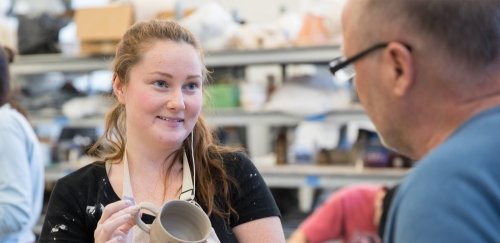Course Information
Here we provide information on course requirements, course descriptions and an Academic Rhode Map for each program, a semester-by-semester plan to help you toward graduation in four years.

The Bachelor of Arts (BA) in Studio Art program offers instruction in ceramics, digital media, graphic design, metalsmithing & jewelry, painting, photography, printmaking, and sculpture. These studio concentrations are supported by courses in art history and a comprehensive foundations program consisting of courses in drawing, 2-D and 3-D design, and digital media. The Studio Art curriculum encourages and fosters creative exploration and an interdisciplinary approach. This degree is an excellent option for students who plan to minor in a related discipline, such as art history, or double-major in another department.
Studio art majors begin their studies with a series of courses in drawing, 2-D and 3-D design, and digital media. While completing the foundations program, you will select an area of concentration and review a plan of study with your art faculty advisor.
Learn about our studio concentrations:
Here we provide information on course requirements, course descriptions and an Academic Rhode Map for each program, a semester-by-semester plan to help you toward graduation in four years.
Note: For information on transferring credit for courses taken at another institution or credit for advanced placement art courses, see Art Transfer Students or obtain guidelines in the main office of ALEX AND ANI Hall.
Upon completion of this program, students will be able to:
The Art Department offers three separate undergraduate majors: art education, art history and studio art. Across these areas, students will learn to write clearly and analytically about works of art, whether they are made by the students themselves or by other artists.
If you are pursuing the studio art major (B.A. or B.F.A.), you must be able to write clear and interesting artist statements, job applications, and grant and commission proposals.
If you are pursuing the art history major, especially if you are interested in graduate studies, you must be able to write research papers. Jobs in museums and galleries require the ability to write clearly and concisely, including descriptions of artworks, business letters and grant applications.
If you are pursuing the art education major, you must be able to write lesson plans and other kinds of documents specific to the education field.
Two courses satisfy the WID requirement for all three majors in the Art Department: Art 231: Prehistoric to Renaissance Art and Art 232: Renaissance to Modern Art. If you are an art studio major, area-specific writing in upper-level studio classes complements the writing in art history. If you are an art education major, you will write in numerous upper-level courses, as well.
The genres of writing students in the Art Department learn to write vary by major. In Art 231 and 232 students write descriptions, analyses and comparisons of individual artworks – these are the most basic components of writing in art and must be mastered to develop either as an artist, art educator or art historian.
In advanced and upper level courses, art students write research papers and responses to art historical scholarship, learning to integrate the ideas of other writers into their work and to deepen their understanding of artworks and art movements.
You will encounter many different kinds of teaching practices, including scaffolded writing projects, peer review, in-class writing, writing-to-learn exercises and discussions of and lectures on writing and writing assignments.
Write interpretive descriptions and comparisons of artworks, thesis papers based on artworks, research papers, artist statements, cover letters and project proposals.
Declaring a minor allows you to explore other areas of interest and make interdisciplinary connections. Minor areas at RIC complement and reinforce all major areas of study. By declaring a minor, you can set yourself apart as a candidate for job, internship and volunteer opportunities.
A strong foundation is essential to understanding the basic concepts you will use in your study of art. Therefore, you will begin your course of study by completing seven courses in drawing, two-dimensional design, three-dimensional design and digital media during your first four semesters. Learn more about the foundations program, and see examples of student work on the foundations page.